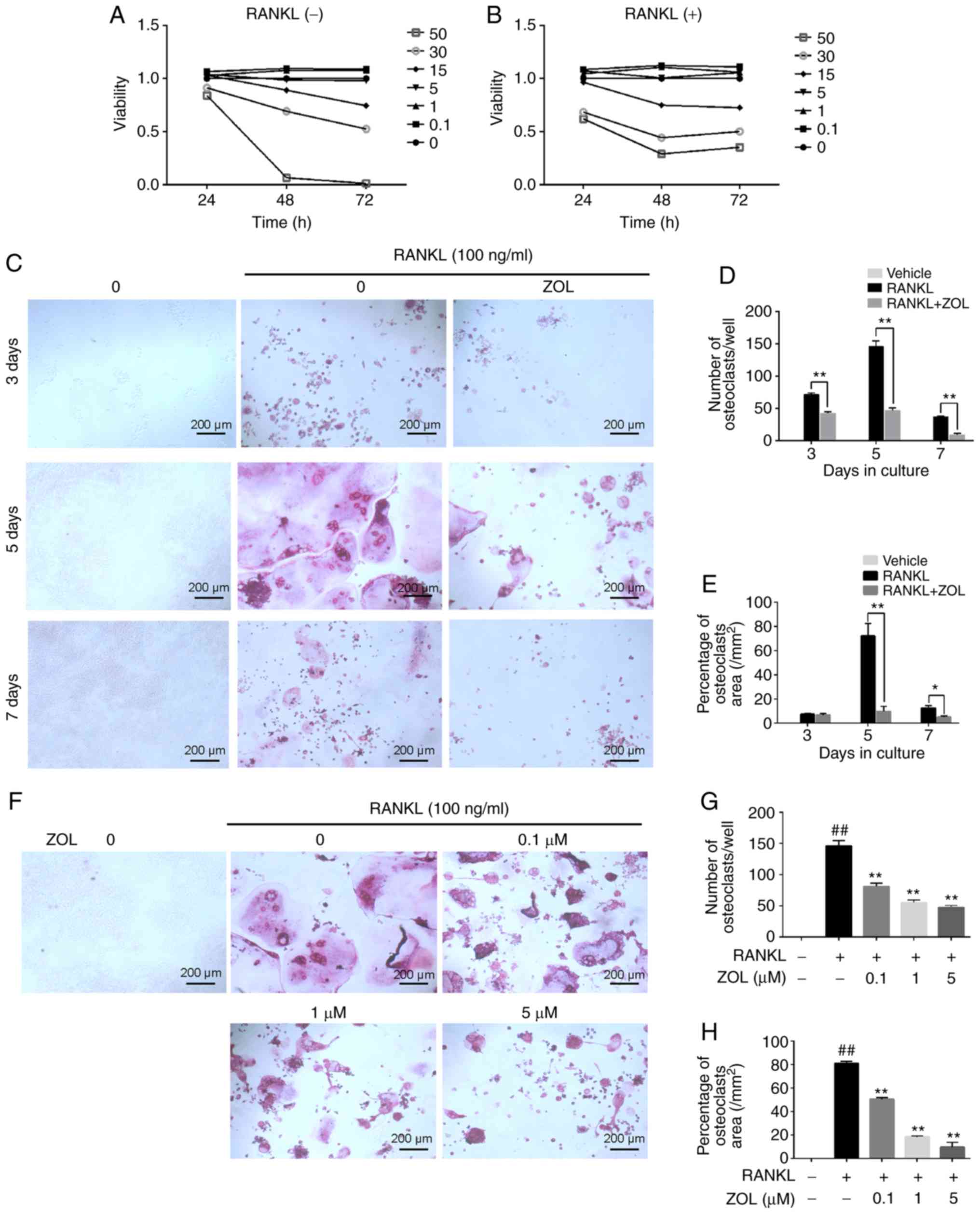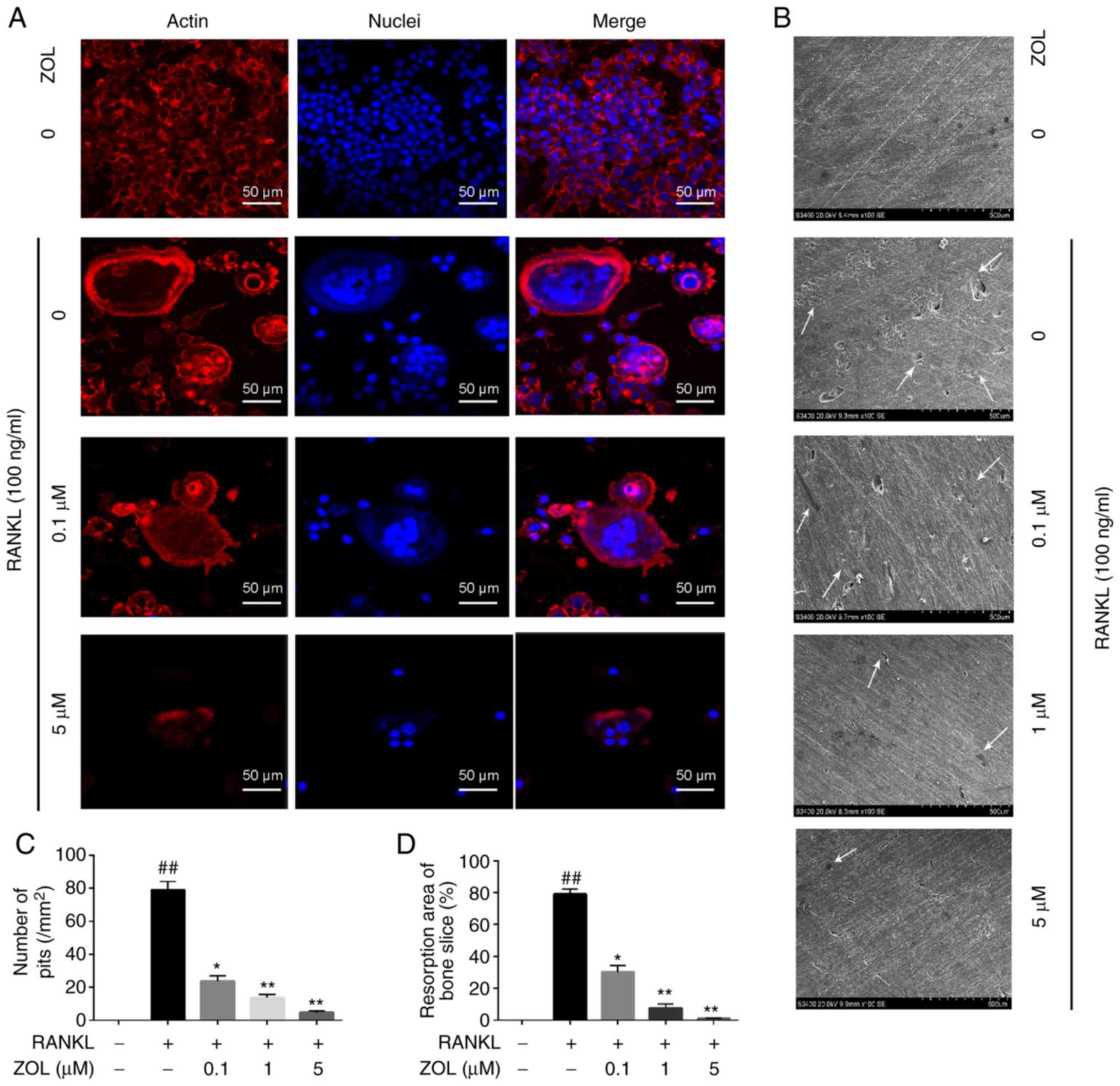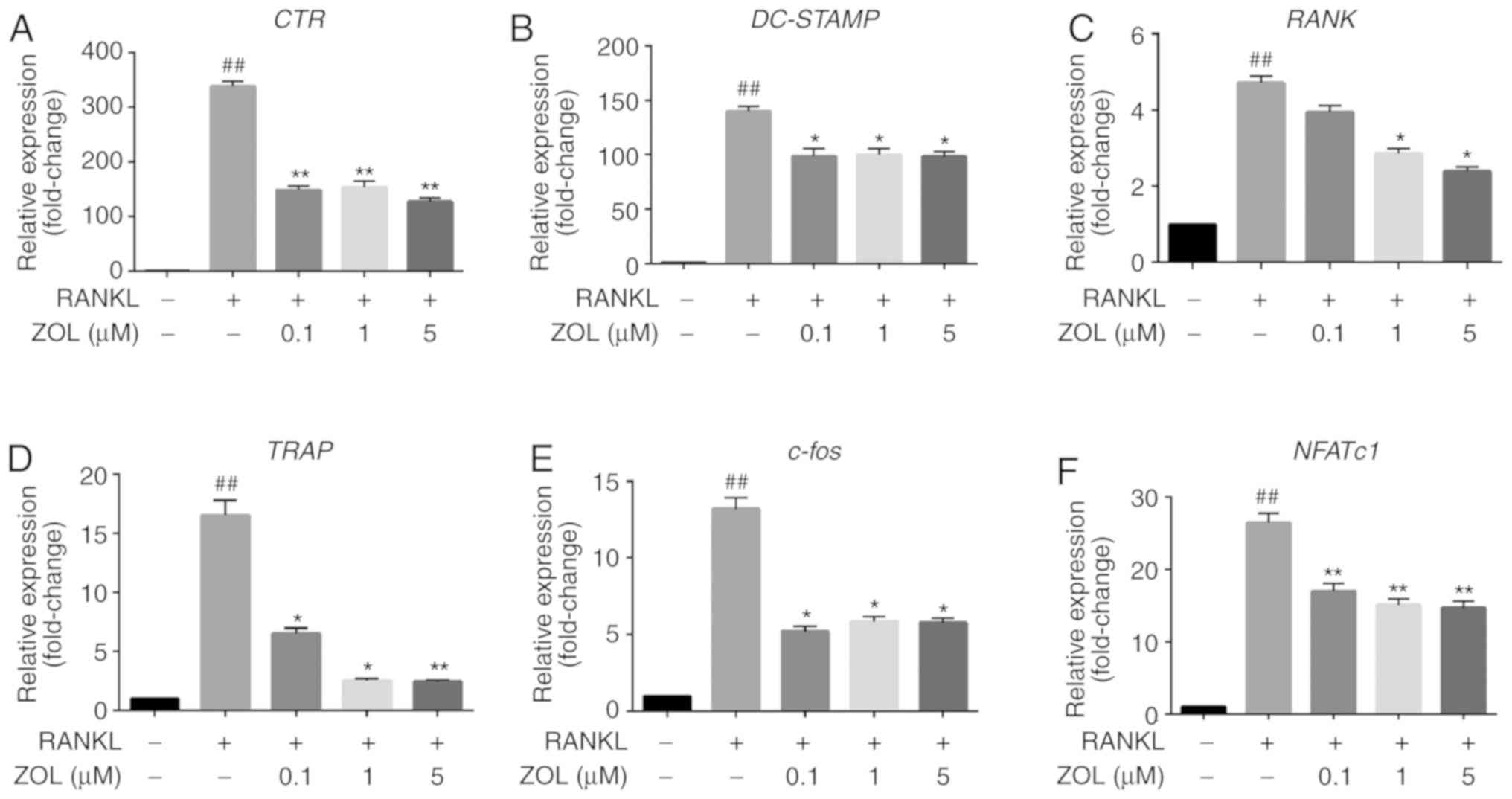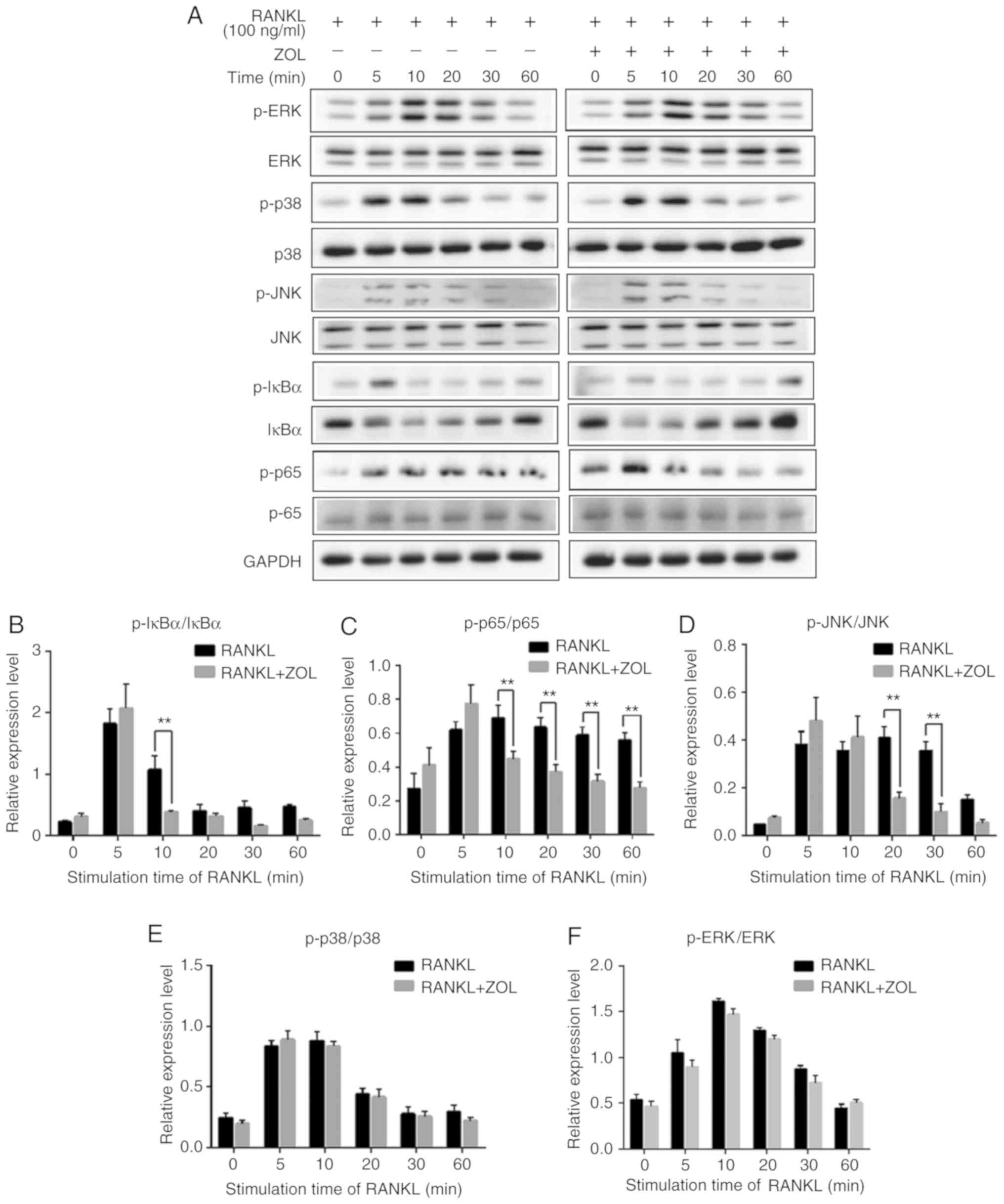|
1
|
Kim HS, Suh KS, Sul D, Kim BJ, Lee SK and
Jung WW: The inhibitory effect and the molecular mechanism of
glabridin on RANKL-induced osteoclastogenesis in RAW264.7 cells.
Int J Mol Med. 29:169–177. 2012.
|
|
2
|
Villa A, Guerrini MM, Cassani B, Pangrazio
A and Sobacchi C: Infantile malignant, autosomal recessive
osteopetrosis: The rich and the poor. Calcif Tissue Int. 84:1–12.
2009. View Article : Google Scholar
|
|
3
|
Boyle WJ, Simonet WS and Lacey DL:
Osteoclast differentiation and activation. Nature. 423:337–342.
2003. View Article : Google Scholar : PubMed/NCBI
|
|
4
|
Teitelbaum SL: Bone resorption by
osteoclasts. Science. 289:1504–1508. 2000. View Article : Google Scholar : PubMed/NCBI
|
|
5
|
Nijweide PJ, Burger EH and Feyen JH: Cells
of bone: Proliferation, differentiation, and hormonal regulation.
Physiol Rev. 66:855–886. 1986. View Article : Google Scholar : PubMed/NCBI
|
|
6
|
Soysa NS, Alles N, Aoki K and Ohya K:
Osteoclast formation and differentiation: An overview. J Med Dent
Sci. 59:65–74. 2012.PubMed/NCBI
|
|
7
|
Zeng Z, Zhang C and Chen J:
Lentivirus-mediated RNA interference of DC-STAMP expression
inhibits the fusion and resorptive activity of human osteoclasts. J
Bone Miner Metab. 31:409–416. 2013. View Article : Google Scholar : PubMed/NCBI
|
|
8
|
Zeng XZ, He LG, Wang S, Wang K, Zhang YY,
Tao L, Li XJ and Liu SW: Aconine inhibits RANKL-induced osteoclast
differentiation in RAW264.7 cells by suppressing NF-κB and NFATc1
activation and DC-STAMP expression. Acta Pharmacol Sin. 37:255–263.
2016. View Article : Google Scholar
|
|
9
|
Oikawa T, Kuroda Y and Matsuo K:
Regulation of osteoclasts by membrane-derived lipid mediators. Cell
Mol Life Sci. 70:3341–3353. 2013. View Article : Google Scholar : PubMed/NCBI
|
|
10
|
Liou YM, Chan CL, Huang R and Wang CA:
Effect of l-caldesmon on osteoclastogenesis in RANKL-induced
RAW264.7 cells. J Cell Physiol. 233:6888–6901. 2018. View Article : Google Scholar : PubMed/NCBI
|
|
11
|
Islam R, Bae HS, Yoon WJ, Woo KM, Baek JH,
Kim HH, Uchida T and Ryoo HM: Pin1 regulates osteoclast fusion
through suppression of the master regulator of cell fusion
DC-STAMP. J Cell Physiol. 229:2166–2174. 2014. View Article : Google Scholar : PubMed/NCBI
|
|
12
|
Abe K, Yoshimura Y, Deyama Y, Kikuiri T,
Hasegawa T, Tei K, Shinoda H, Suzuki K and Kitagawa Y: Effects of
bisphosphonates on osteoclastogenesis in RAW264.7 cells. Int J Mol
Med. 29:1007–1015. 2012.PubMed/NCBI
|
|
13
|
Mediero A, Perez-Aso M and Cronstein BN:
Activation of adenosine A(2A) receptor reduces osteoclast formation
via PKA- and ERK1/2-mediated suppression of NFκB nuclear
trans-location. Br J Pharmacol. 169:1372–1388. 2013. View Article : Google Scholar : PubMed/NCBI
|
|
14
|
Lacey DL, Timms E, Tan HL, Kelley MJ,
Dunstan CR, Burgess T, Elliott R, Colombero A, Elliott G, Scully S,
et al: Osteoprotegerin ligand is a cytokine that regulates
osteoclast differentiation and activation. Cell. 93:165–176. 1998.
View Article : Google Scholar : PubMed/NCBI
|
|
15
|
Yuan M, Chen J and Zeng Z: Knockdown of
macrophage inhibitory cytokine-1 in RPMI-8226 human multiple
myeloma cells inhibits osteoclastic differentiation through
inhibiting the RANKL-Erk1/2 signaling pathway. Mol Med Rep.
14:5199–5204. 2016. View Article : Google Scholar : PubMed/NCBI
|
|
16
|
Wada T, Nakashima T, Hiroshi N and
Penninger JM: RANKL-RANK signaling in osteoclastogenesis and bone
disease. Trends Mol Med. 12:17–25. 2006. View Article : Google Scholar
|
|
17
|
Huang P, Han J and Hui L: MAPK signaling
in inflammation- associated cancer development. Protein Cell.
1:218–226. 2010. View Article : Google Scholar
|
|
18
|
Ihn HJ, Lee D, Lee T, Shin HI, Bae YC, Kim
SH and Park EK: The 1,2,3-triazole derivative KP-A021 suppresses
osteoclast differentiation and function by inhibiting
RANKL-mediated MEK-ERK signaling pathway. Exp Biol Med (Maywood).
240:1690–1697. 2015. View Article : Google Scholar
|
|
19
|
Negishi-Koga T and Takayanagi H:
Ca2+-NFATc1 signaling is an essential axis of osteoclast
differentiation. Immunol Rev. 231:241–256. 2009. View Article : Google Scholar : PubMed/NCBI
|
|
20
|
Zhang Y, Wang Z, Xie X, Wang J, Wang Y,
Peng QS, Zhang M, Wu D, Liu N, Wang HB and Sun WC: Tatarinan N
inhibits osteoclast differentiation through attenuating NF-κB,
MAPKs and Ca2+-dependent signaling. Int Immunopharmacol.
65:199–211. 2018. View Article : Google Scholar : PubMed/NCBI
|
|
21
|
Nakashima T and Takayanagi H:
Osteoimmunology: Crosstalk between the immune and bone systems. J
Clin Immunol. 29:555–567. 2009. View Article : Google Scholar : PubMed/NCBI
|
|
22
|
Lambrinoudaki I, Vlachou S, Galapi F,
Papadimitriou D and Papadias K: Once-yearly zoledronic acid in the
prevention of osteoporotic bone fractures in postmenopausal women.
Clin Interv Aging. 3:445–451. 2008. View Article : Google Scholar : PubMed/NCBI
|
|
23
|
Dalle Carbonare L, Zanatta M, Gasparetto A
and Valenti MT: Safety and tolerability of zoledronic acid and
other bisphosphonates in osteoporosis management. Drug Healthc
Patient Saf. 2:121–137. 2010. View Article : Google Scholar : PubMed/NCBI
|
|
24
|
Benford HL, McGowan NW, Helfrich MH,
Nuttall ME and Rogers MJ: Visualization of bisphosphonate-induced
caspase-3 activity in apoptotic osteoclasts in vitro. Bone.
28:465–473. 2001. View Article : Google Scholar : PubMed/NCBI
|
|
25
|
Yasen M, Li X, Jiang L, Yuan W, Che W and
Dong J: Effect of zoledronic acid on spinal fusion outcomes in an
ovariectomized rat model of osteoporosis. J Orthop Res.
33:1297–1304. 2015. View Article : Google Scholar : PubMed/NCBI
|
|
26
|
Kimachi K, Kajiya H, Nakayama S, Ikebe T
and Okabe K: Zoledronic acid inhibits RANK expression and migration
of osteoclast precursors during osteoclastogenesis. Naunyn
Schmiedebergs Arch Pharmacol. 383:297–308. 2011. View Article : Google Scholar : PubMed/NCBI
|
|
27
|
Tsubaki M, Komai M, Itoh T, Imano M,
Sakamoto K, Shimaoka H, Takeda T, Ogawa N, Mashimo K, Fujiwara D,
et al: Nitrogen-containing bisphosphonates inhibit RANKL- and
M-CSF-induced osteoclast formation through the inhibition of ERK1/2
and Akt activation. J Biomed Sci. 21:102014. View Article : Google Scholar : PubMed/NCBI
|
|
28
|
Tai TW, Su FC, Chen CY, Jou IM and Lin CF:
Activation of p38 MAPK-regulated Bcl-xL signaling increases
survival against zoledronic acid-induced apoptosis in osteoclast
precursors. Bone. 67:166–174. 2014. View Article : Google Scholar : PubMed/NCBI
|
|
29
|
Livak KJ and Schmittgen TD: Analysis of
relative gene expression data using real-time quantitative PCR and
the 2(−Delta Delta C(T)) method. Methods. 25:402–408. 2001.
View Article : Google Scholar
|
|
30
|
Teitelbaum SL: Osteoclasts: What do they
do and how do they do it? Am J Pathol. 170:427–435. 2007.
View Article : Google Scholar : PubMed/NCBI
|
|
31
|
Jurdic P, Saltel F, Chabadel A and
Destaing O: Podosome and sealing zone: Specificity of the
osteoclast model. Eur J Cell Biol. 85:195–202. 2006. View Article : Google Scholar : PubMed/NCBI
|
|
32
|
Stevenson DA, Schwarz EL, Carey JC,
Viskochil DH, Hanson H, Bauer S, Weng HY, Greene T, Reinker K,
Swensen J, et al: Bone resorption in syndromes of the Ras/MAPK
pathway. Clin Genet. 80:566–573. 2011. View Article : Google Scholar : PubMed/NCBI
|
|
33
|
Suda T, Kobayashi K, Jimi E, Udagawa N and
Takahashi N: The molecular basis of osteoclast differentiation and
activation. Novartis Found Symp. 232:235–247; discussion 247-250.
2001.PubMed/NCBI
|
|
34
|
Li DZ, Zhang QX, Dong XX, Li HD and Ma X:
Treatment with hydrogen molecules prevents RANKL-induced osteoclast
differentiation associated with inhibition of ROS formation and
inactivation of MAPK, AKT and NF-kappa B pathways in murine
RAW264.7 cells. J Bone Miner Metab. 32:494–504. 2014. View Article : Google Scholar
|
|
35
|
Ikeda F, Nishimura R, Matsubara T, Tanaka
S, Inoue J, Reddy SV, Hata K, Yamashita K, Hiraga T, Watanabe T, et
al: Critical roles of c-Jun signaling in regulation of NFAT family
and RANKL-regulated osteoclast differentiation. J Clin Invest.
114:475–484. 2004. View Article : Google Scholar : PubMed/NCBI
|
|
36
|
Ikeda F, Matsubara T, Tsurukai T, Hata K,
Nishimura R and Yoneda T: JNK/c-Jun signaling mediates an
anti-apoptotic effect of RANKL in osteoclasts. J Bone Miner Res.
23:907–914. 2008. View Article : Google Scholar : PubMed/NCBI
|
|
37
|
Siddiqi MH, Siddiqi MZ, Kang S, Noh HY,
Ahn S, Simu SY, Aziz MA, Sathishkumar N, Jiménez Pérez ZE and Yang
DC: Inhibition of osteoclast differentiation by ginsenoside rg3 in
RAW264.7 cells via RANKL, JNK and p38 MAPK pathways through a
modulation of cathepsin k: An in silico and in vitro study.
Phytother Res. 29:1286–1294. 2015. View Article : Google Scholar : PubMed/NCBI
|
|
38
|
Feng X and McDonald JM: Disorders of bone
remodeling. Annu Rev Pathol. 6:121–145. 2011. View Article : Google Scholar
|
|
39
|
Wu K, Lin TH, Liou HC, Lu DH, Chen YR, Fu
WM and Yang RS: Dextromethorphan inhibits osteoclast
differentiation by suppressing RANKL-induced nuclear factor-κB
activation. Osteoporos Int. 24:2201–2214. 2013. View Article : Google Scholar : PubMed/NCBI
|
|
40
|
Kang MR, Jo SA, Yoon YD, Park KH, Oh SJ,
Yun J, Lee CW, Nam KH, Kim Y, Han SB, et al: Agelasine D suppresses
RANKL-induced osteoclastogenesis via down-regulation of c-Fos,
NFATc1 and NF-κB. Mar Drugs. 12:5643–5656. 2014. View Article : Google Scholar : PubMed/NCBI
|
|
41
|
Lee CC, Liu FL, Chen CL, Chen TC, Chang DM
and Huang HS: Discovery of 5-(2′,4′-difluorophenyl)-salicylanilides
as new inhibitors of receptor activator of NF-κB ligand
(RANKL)-induced osteoclastogenesis. Eur J Med Chem. 98:115–126.
2015. View Article : Google Scholar : PubMed/NCBI
|
|
42
|
Liu W and Zhang X: Receptor activator of
nuclear factor-κB ligand (RANKL)/RANK/osteoprotegerin system in
bone and other tissues (review). Mol Med Rep. 11:3212–3218. 2015.
View Article : Google Scholar : PubMed/NCBI
|
|
43
|
Zhao XL, Chen JJ, Si SY, Chen LF and Wang
Z: T63 inhibits osteoclast differentiation through regulating MAPKs
and Akt signaling pathways. Eur J Pharmacol. 834:30–35. 2018.
View Article : Google Scholar : PubMed/NCBI
|
|
44
|
Kim HJ, Yoon KA, Lee MK, Kim SH, Lee IK
and Kim SY: A novel small molecule, NecroX-7, inhibits osteoclast
differentiation by suppressing NF-κB activity and c-Fos expression.
Life Sci. 91:928–934. 2012. View Article : Google Scholar : PubMed/NCBI
|
|
45
|
Leotoing L, Wauquier F, Guicheux J,
Miot-Noirault E, Wittrant Y and Coxam V: The polyphenol fisetin
protects bone by repressing NF-κB and MKP-1-dependent signaling
pathways in osteoclasts. PLoS One. 8:e683882013. View Article : Google Scholar
|
|
46
|
Kong X, Wu W, Yang Y, Wan H, Li X, Zhong
M, Zhao H, Su X, Jia S, Ju D and Lin N: Total saponin from Anemone
flaccida Fr. Schmidt abrogates osteoclast differentiation and bone
resorption via the inhibition of RANKL-induced NF-κB, JNK and p38
MAPKs activation. J Transl Med. 13:912015. View Article : Google Scholar
|
|
47
|
Xu X, Liu N, Wang Y, Pan LC, Wu D, Peng Q,
Zhang M, Wang HB and Sun WC: Tatarinan O, a lignin-like compound
from the roots of Acorus tatarinowii Schott inhibits osteoclast
differentiation through suppressing the expression of c-Fos and
NFATc1. Int Immunopharmacol. 34:212–219. 2016. View Article : Google Scholar : PubMed/NCBI
|
|
48
|
Fliefel R, Troltzsch M, Kuhnisch J,
Ehrenfeld M and Otto S: Treatment strategies and outcomes of
bisphosphonate-related osteonecrosis of the jaw (BRONJ) with
characterization of patients: A systematic review. Int J Oral
Maxillofac Surg. 44:568–585. 2015. View Article : Google Scholar : PubMed/NCBI
|
|
49
|
Sakaguchi O, Kokuryo S, Tsurushima H,
Tanaka J, Habu M, Uehara M, Nishihara T and Tominaga K:
Lipopolysaccharide aggravates bisphosphonate-induced osteonecrosis
in rats. Int J Oral Maxillofac Surg. 44:528–534. 2015. View Article : Google Scholar
|
|
50
|
Wachi T, Shuto T, Shinohara Y, Matono Y
and Makihira S: Release of titanium ions from an implant surface
and their effect on cytokine production related to alveolar bone
resorption. Toxicology. 327:1–9. 2015. View Article : Google Scholar
|
|
51
|
Baek JM, Kim JY, Lee CH, Yoon KH and Lee
MS: Methyl gallate inhibits osteoclast formation and function by
suppressing Akt and Btk-PLCgamma2-Ca(2+) signaling and prevents
lipo-polysaccharide-induced bone loss. Int J Mol Sci. 18:E5812017.
View Article : Google Scholar
|
|
52
|
Sun X, Wei J, Lyu J, Bian T, Liu Z, Huang
J, Pi F, Li C and Zhong Z: Bone-targeting drug delivery system of
biomineral-binding liposomes loaded with icariin enhances the
treatment for osteoporosis. J Nanobiotechnology. 17:102019.
View Article : Google Scholar : PubMed/NCBI
|
|
53
|
Yasuda H: The mechanism of anti-RANKL
antibody in the treatment of metabolic bone diseases including
osteoporosis-possible applications of anti-RANKL antibody to the
treatment of cancer patients. Nihon Yakurigaku Zasshi. 153:11–15.
2019.In Japanese. View Article : Google Scholar
|
|
54
|
Moen MD and Keam SJ: Denosumab: A review
of its use in the treatment of postmenopausal osteoporosis. Drugs
Aging. 28:63–82. 2011. View Article : Google Scholar
|
|
55
|
Sidlauskas KM, Sutton EE and Biddle MA:
Osteoporosis in men: Epidemiology and treatment with denosumab.
Clin Interv Aging. 9:593–601. 2014.PubMed/NCBI
|
|
56
|
Tai TW, Chen CY, Su FC, Tu YK, Tsai TT,
Lin CF and Jou IM: Reactive oxygen species are required for
zoledronic acid-induced apoptosis in osteoclast precursors and
mature osteoclast-like cells. Sci Re. 7:442452017.
|
|
57
|
Lyles KW, Colon-Emeric CS, Magaziner JS,
Adachi JD, Pieper CF, Mautalen C, Hyldstrup L, Recknor C,
Nordsletten L, Moore KA, et al: Zoledronic acid and clinical
fractures and mortality after hip fracture. N Engl J Med.
357:1799–1809. 2007. View Article : Google Scholar : PubMed/NCBI
|



















